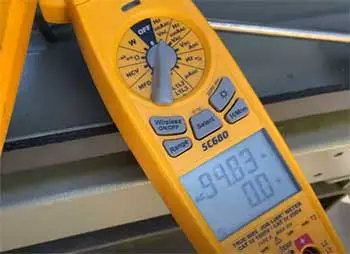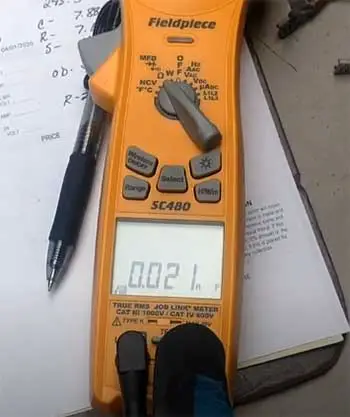When it comes to electrical troubleshooting and HVAC work, having a reliable multimeter at your side is essential. Two of the top options electricians and technicians turn to are the Fieldpiece SC480 and SC680 models.
But what exactly sets them apart and makes one potentially better than the other?
In this comprehensive guide, we’ll explore the key features, pros and cons, and primary differences between the Fieldpiece SC480 and SC680 to help you determine the best choice.
Whether you’re an aspiring technician or seasoned professional, an informed decision can save you time, money, and headaches down the road.
Side-By-Side Comparison Chart
Here is a quick overview of the key specifications and differences:
| Feature | Fieldpiece SC480 | Fieldpiece SC680 |
| Price | $$ | $$$ |
| Accuracy | True RMS | True RMS |
| Counts | 6000 | 6000 |
| Low Impedance Mode | No | Yes |
| Voltage Safety Rating | CAT III 600V<br>CAT IV 300V | CAT IV 600V<br>CAT III 1000V |
| Current Capability | 600A AC | 1000A AC/DC |
| Jaw Opening | 2.0 inches | 1.2 inches (removable iFlex clamp) |
| Non-Contact Voltage Detector | Yes | Yes |
| Infrared Thermometer | No | Triple laser with targeting |
| Temperature Probes | No | Supports Type K |
| Min/Max Recording | Yes | Yes |
| Warranty | 2 years | 3 years |
Overview Of The SC480 Multimeter
The Fieldpiece SC480 True RMS Clamp Multimeter first hit markets back in 2017 but still remains a popular pick thanks to its versatile feature set. Here’s a quick rundown of what it brings to the table:
Key Features:

- True RMS for accurate voltage and current readings on nonlinear loads
- Built-in non-contact voltage detector
- Low impedance mode to eliminate phantom voltages
- Microamps mode for testing flame sensors
- Min/Max/Avg recording to detect intermittent issues
- Large backlit display with secondary reading line
- Dual LED worklights to illuminate dark areas
- Cat III 600V and Cat IV 300V safety ratings
This clamp-style digital multimeter allows current measurements up to 600 amps AC by clamping around a single conductor.
The large jaw opening makes it easy to fit around thicker cables.
Voltage, resistance, continuity, frequency, and capacitance measurements are handled through standard test leads.
In terms of size and form, the SC480 is quite compact and lightweight while still offering a well-sized display and buttons. The rotary dial allows for quick mode selections. An integrated hanging strap also makes storage easy between uses.
Overall, it strikes a nice balance between performance, durability, and affordability. Many electricians swear by the SC480 as their go-to multimeter for routine testing and troubleshooting.
Overview Of The SC680 Multimeter
Meanwhile, the Fieldpiece SC680 was released in 2020 as a high-end model designed for HVAC pros and electricians that needed maximum functionality.
Key Features:

- True RMS readings with 6000 count display
- CAT IV-600V and CAT III-1000V safety ratings
- Low Z volt alert to detect phantom/ghost voltages
- LoZ mode (low impedance) to eliminate phantom voltages
- Auto-ranging voltage, current, resistance, continuity, diode, and capacitance measurements
- Large backlit digital display with secondary line
- Integrated non-contact voltage detection
- Triple infrared thermometer with laser targeting
- Temperature, dew point, and wet bulb readings
- Current measurements up to 1000A AC/DC with iFlex clamp
- Min/Max/Avg recording to find intermittent faults
- Integrated accessory storage under the lid
This model really aims to justify its higher price with enhanced versatility for field service applications. The removable iFlex clamp allows much higher current measurements while providing greater flexibility to loop around wires in tight spaces.
You also have the convenience of onboard Type K thermocouple jacks for temperature readings without carrying a separate instrument. Given how critical proper temperatures are to HVAC systems, this adds quite a bit of value.
The onboard non-contact infrared thermometer is ideal for checking motors, coils, bearings and more.
All in all, it’s a professional grade multimeter stacked with functionality to handle a wide variety of field testing and troubleshooting tasks. If budget isn’t too much of a constraint, the SC680 really packs a punch.
Head-To-Head Comparison of Fieldpiece SC480 And SC680 Multimeters
Now that you have a general idea of what each model brings to the table, let’s take a closer look at how they stack up across some of the most important categories:
Accuracy Of Readings
Both the SC480 and SC680 offer true RMS readings for accurate measurements on nonlinear loads – an important capability for modern electrical work. This allows proper analysis of the waveforms from inverters, VFDs, UPS systems, and other dirty power sources that older analog meters would struggle with.
As for display resolution, you have:
- SC480 – 6000 counts
- SC680 – 6000 counts
The higher number of counts on the display allows for greater precision when taking readings. Both offer suitable resolution for most needs.
One unique feature of the SC680 though is the low impedance mode and ghost/phantom voltage alert. This allows detection of unwanted voltages that may influence readings and cause inaccurate troubleshooting. Electricians may encounter phantom voltages when working with sensitive control circuits and electronics.
Overall, while both models offer excellent accuracy and true RMS capabilities, the SC680 provides added functionality to alert users to potential ghost voltages that could skew results.
Electrical Safety Ratings
When dealing with live voltages, the safety rating of your multimeter is critically important. Here’s how the two Fieldpiece models compare:
- SC480 – CAT III 600V, CAT IV 300V
- SC680 – CAT IV 600V, CAT III 1000V
The higher categories and voltage limits on the SC680 make it suitable for dealing with high energy distribution systems. This includes 3-phase motors, large feeder lines, and other heavy electrical equipment.
If you routinely work with higher voltage commercial or industrial systems, the extra protection on the SC680 is worth the investment. The SC480 still offers ample safety margins for general electrical tasks though.
Current Measurement Capabilities
Clamp-style multimeters are incredibly handy for measuring current without breaking the circuit. Here is what each model offers:
- SC480 – Measures up to 600A AC; jaw opens to 2.0”
- SC680 – Measures up to 1000A AC/DC with removable iFlex clamp
Again, the SC680 pulls ahead thanks to the extremely versatile iFlex clamp. Not only can you measure higher currents up to 1000A, but the slender clamp design makes navigating cramped wire bundles far easier. The generous 2” jaw opening on the SC480 is fine for general troubleshooting but has limitations in tighter spaces.
Added Features & Functionality

Beyond the core voltage, current, and continuity functions, advanced multimeters incorporate added functionality to improve field use.
This is where the SC680 really starts to justify its higher price point.
For starters, you have the integrated non-contact voltage detection that allows live circuit testing without test leads.
The triple laser infrared thermometer also lets you take non-contact temperature measurements of electrical components and trouble spots.
Very handy for HVAC technicians.
You also have Type K thermocouple ports built-in for temperature readings of liquids, gases, and environmental conditions. Measuring dew point and wet bulb temperatures are a breeze with supporting probes. All these features really expand the measurement capabilities on a single instrument.
Other extras like MIN/MAX recording, integrated worklights and accessory storage make the SC680 highly versatile for field applications. It’s pricey, but packed with functionality.
Frequently Asked Questions (FAQ)
In general, most electricians and technicians keep both a multimeter and clamp meter on hand to cover all testing scenarios. Here are the advantages of each:
Multimeter – Measures voltage, current, resistance, continuity, capacitance, frequency etc. Very versatile. Requires breaking the circuit to measure current. Manual selection of each range.
Clamp Meter – Specialized for current measurements up to 1000A by clamping around live wires. Very safe and no circuit interruption needed. Typically includes voltage/resistance functions too. Auto-ranging takes the guesswork out.
For most users, having both instruments available in your toolkit is the best approach as they complement each other quite well during troubleshooting. A true RMS clamp meter like the Fieldpiece SC480 or SC680 paired with a quality manual multimeter makes a very capable combination.
The core difference comes down to how current measurements are performed:
Digital Multimeter – Requires manually connecting probes in series with the circuit to measure current. You physically open up the circuit and insert the meter leads. Readings typically max out below 10-20A.
Clamp Meter – Uses inductive clamp jaws to measure current flowing through a conductor without any circuit interruption. Just clamp the jaws around a live wire and get a reading up to 1000A. Very safe and convenient.
So in summary – clamps use inductive loops to safely measure high currents while multimeters require physically connecting probes inline and breaking the flow. Advanced models like the SC680 offer both methods in a single convenient package.
Clamp multimeters use a current transformer and Hall Effect sensor to safely measure currents up to 1000A. Here’s a quick summary:
1. The conductor with AC/DC current flow is encircled by the multimeter’s clamp jaw. This can be done on live circuits.
2. An internal transformer produces a magnetic field proportional to the conductor’s actual current.
3. The Hall Effect sensor detects the magnetic field intensity and converts this to a measurable corresponding voltage.
4. The multimeter’s circuitry amplifies the low sensor voltage and scales the signal to accurately display the conductor’s true current on the digital readout.
So in a nutshell, the magnetic field induced by the current flow is detected, converted to a voltage, then amplified/scaled to determine current. This allows safe, non-contact measurements.
Conclusions – Which Is The Best Bet?
So when all is said and done, which model comes out on top – the SC480 or SC680?
For most general electrical/HVAC troubleshooting applications, I think the SC480 hits the best balance of functionality, performance and value. It delivers professional grade accuracy and safety ratings at a very appealing price point.
The versatile clamp jaw design, Min/Max recording and other features handle most common tasks on residential and light commercial jobs. Unless budget is no concern, the SC480 will suit most electricians quite well.
However, for those working extensively on large-scale industrial equipment, 3-phase systems, and other high-energy applications, the SC680 justifies its higher cost through advanced capabilities.
You get maxed out safety margins up to 1000V along with higher current measurements. The removable clamp and integrated temperature functions also boost versatility for commercial HVAC, refrigeration and predictive maintenance needs.
So while the SC480 satisfies general testing/troubleshooting demands for many, those working with higher power equipment on a regular basis can leverage the SC680’s advantages. It really comes down to your specific usage case and budget flexibility.
Either way, both Fieldpiece models are very reliable and deliver professional grade performance.
Hopefully this detailed comparison gives you a clear sense of which multimeter aligns best with your workflow and needs. Never hesitate to reach out with any other questions!
